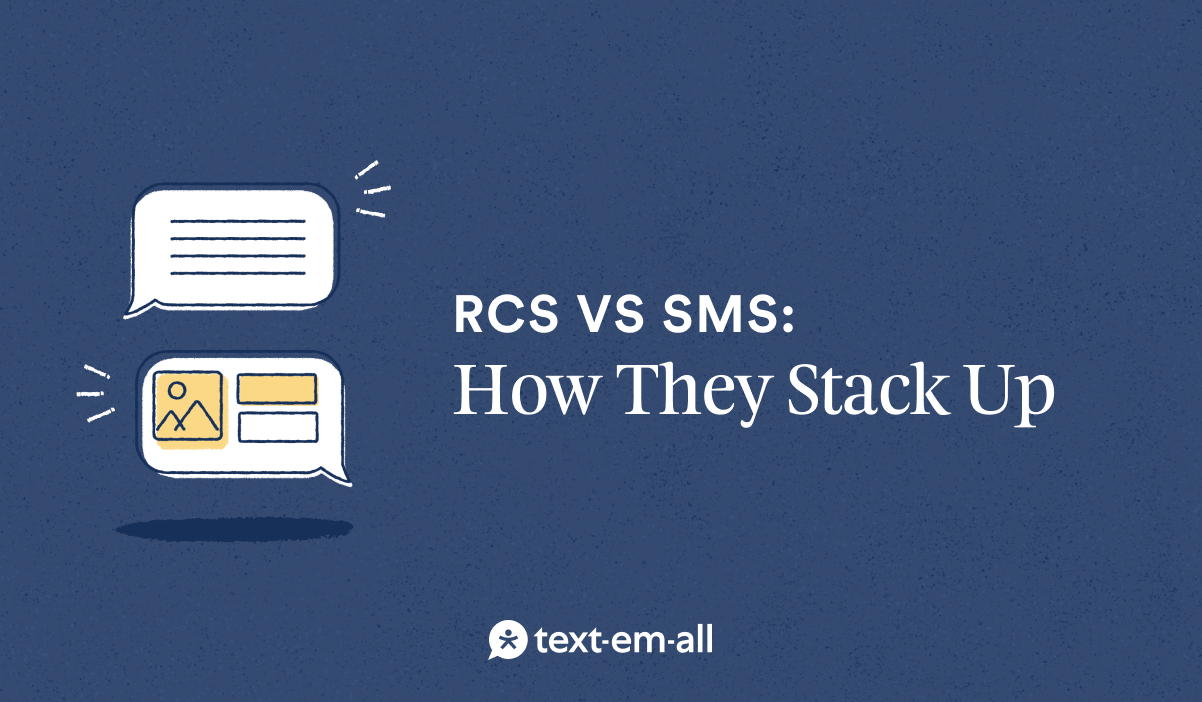
The creation of short message service (SMS) in the early 1990s marked a crucial moment in mobile communication. SMS was a revolutionary concept. It let users send concise text messages between mobile devices, which allowed people to stay connected at all times - something that had never been done before. Its simplicity and ease of use led to widespread adoption, and it’s still most people’s primary form of communication today.
Fast forward to the present day, and a new competitor has finally emerged on the messaging scene—Rich Communication Services (RCS). This next-generation messaging protocol builds upon SMS by offering a more feature-rich, interactive experience.
Below, we’ll explore the fundamental differences between SMS vs. RCS, along with their respective benefits and drawbacks. We’ll also discuss when each technology may be right for your business.
Table of Contents
RCS vs SMS: What's the Difference?
Is RCS or SMS Better for Business Texting?
What Is SMS?
SMS is the oldest and most common form of text messaging. In fact, the first SMS message was sent in 1992—it read “Merry Christmas.” For the past two-plus decades, SMS has been the default text messaging method on mobile phones.
SMS allows users to send text-only messages of up to 160 characters via cellular networks. Since it’s universally supported by all mobile phones and doesn’t require Internet connection, it can help your business reach up to 7.3 billion people around the globe. It can also serve as a backup delivery method if other text messaging options fail.
While other text messaging methods are gaining traction, SMS remains popular for its simplicity, reliability, and affordability. Here are some key features of SMS:
- Universal cellular network connectivity
- Compatibility with virtually all mobile phones
- Standard text messaging rates, which are often included in users’ mobile phone plans
- Simple plain-text formatting
Advantages of SMS
Businesses that use SMS for internal or customer communication enjoy a variety of benefits, including:
1. Reliability & Universal Reach
SMS works on virtually all mobile devices across the globe. Unlike RCS, it doesn't require a smartphone, additional software or internet access. Regardless of your recipients’ mobile phone or cellular carrier, you can rely on SMS messages to reach your recipients, even in areas with poor data connectivity.
2. Cost Effectiveness
SMS is one of the most affordable messaging communication channels. Its text-only simplicity reduces design and development costs. And thanks to its wide reach and high engagement, SMS also boasts high ROI.
3. Familiarity
Since SMS is one of the most commonly used forms of communication, your recipients would already be comfortable interacting with it. In fact, SMS has probably the highest open rate that averages around 98%.
When used for marketing purposes, SMS is considered less intrusive than other channels, boasting higher engagement and conversion rates.
.png?width=889&height=519&name=TEA-172-RCS%20vs%20SMS%20In%20Blog%20Image%20(1).png)
Disadvantages of SMS
While SMS has a lot to offer, it also has some shortcomings. These include:
1. Limited Functionality
SMS’ plain text format limits its ability to engage customers, as there’s little room for custom branding, interactive content, or personalization, making it a less dynamic option than newer text messaging methods.
It is also constrained by its 160-character limit and as a result, it may have less impact than richer forms of text messages, like RCS.
2. Security Concerns
SMS messages don’t feature end-to-end encryption, making them more susceptible to interception and unauthorized access. If your business manages sensitive information or operates in a highly regulated industry, this lack of security may present compliance concerns.
3. Limited Analytics
SMS doesn’t come with modern messaging features like read receipts, so you can’t confirm if the recipient has opened your message. There are no typing indicators, which means you won’t know if someone is responding in real time. Additionally, SMS only offers limited delivery notifications, and even these depend on the carrier and messaging platform.
What is RCS?
Introduced in 2007, RCS is a next-generation communication protocol developed to replace SMS and MMS, offering advanced features similar to popular messaging apps like WhatsApp or iMessage, such as:
- Read receipts
- Typing indicators
- Message delivery notifications
- Branded visuals, logos, and interactive elements
- Suggested replies, action buttons, and carousels
- Multimedia sharing (audio, video, more emojis, larger, higher quality images)
- Better group chat capabilities
- Increased security
Unlike SMS, which rely on cellular networks, RCS operates over mobile data or Wi-Fi.
The adoption of RCS has been gradual. A major factor has been its lack of support on Apple devices until September 2024, despite Google's persistent advocacy for its adoption. Although Apple incorporated RCS following public pressure in 2024, it continues prioritizing iMessage as its most advanced messaging platform.
Overall, RCS is designed to provide a more engaging and dynamic platform for mobile communication and aims to set a new standard for the messaging world.
Advantages of RCS
Here are some ways RCS messaging is poised to improve how businesses communicate with their contacts.
1. Enhanced User Experience
RCS provides users with a more dynamic and interactive messaging experience, going beyond the limitations of traditional SMS. Incorporating read receipts, typing indicators, and delivery notifications enhances user engagement.
2. Multimedia Support
With RCS, businesses can seamlessly share high-resolution multimedia content, such as images, videos, or even entire product catalogs, without compromising quality. The ability to convey information visually improves the message's appeal and effectiveness.
3. Branding Opportunities
RCS offers unique branding capabilities that allow businesses to incorporate logos, visuals, and interactive elements within messages for a more professional and brand-consistent messaging experience. This reinforces brand identity, building customer trust and recognition through each interaction.
4. Group Chat Capabilities
RCS excels in group chatting, offering businesses better features to create and moderate group discussions. This is ideal for team projects, customer support forums, or broadcasting information to broader audiences, fostering a collaborative and engaging environment.
5. Interactive Elements
Built-in rich cards, suggested replies, single-click buttons, and carousels transform RCS into an interactive powerhouse. Businesses can guide users through specific actions, simplifying processes like appointment confirmations or purchases.
6. Read Receipts and Delivery Notifications
RCS provides transparency by enabling users to see when their messages have been read. Real-time delivery notifications also give businesses updates on the status of sent messages, ensuring a reliable messaging experience.
7. Versatility for Business Communication
The robust capabilities of RCS support different business communication needs, from marketing campaigns and transactional updates to customer support interactions. Its dynamic nature ensures comprehensive coverage for diverse scenarios.
8. Increased Security
RCS integrates modern security protocols to protect communication, addressing common vulnerabilities of SMS. This raises the bar for secure and trustworthy business messaging.
Disadvantages of RCS
While RCS Messaging promises numerous advancements, it's not without its drawbacks. Here are a few to consider:
1. Limited Adoption
RCS adoption has been slow largely due to fragmented implementation across carriers and devices, which has limited its availability. For example, until Apple's recent adoption of RCS with iOS 18, the service was primarily limited to Android users, creating a divide that hindered cross-platform communication.
2. Internet Dependency
RCS relies on an active internet connection, such as Wi-Fi or mobile data, to send and receive messages. This means it may not work reliably in areas with poor or no connectivity, unlike SMS, which functions on basic cellular networks.
3. Cost
RCS messaging is generally more expensive for businesses than SMS. And while it’s still cost-effective, there may be variations in pricing models depending on carriers and regions. Moreover, using features like rich media, interactive buttons, or branded templates would require more resources for creative development.
RCS vs SMS: What's the Difference?
To clarify the key differences between SMS vs. RCS, let’s quickly compare their core functionalities, security aspects, and user experiences.
- Functionality — RCS introduces advanced functionalities that go beyond the capabilities of traditional SMS. With high-quality media sharing, group chat capabilities, and real-time interaction indicators, RCS offers a more comprehensive and interactive messaging experience. SMS, while reliable, lacks these features, making it a more straightforward communication platform.
- Security — One area where RCS shines is in security. SMS has faced challenges, including vulnerabilities like SIM swapping. RCS, on the other hand, is designed with modern security protocols, offering a more robust defense against potential threats. This enhanced security can be crucial, especially for businesses relying on secure and confidential communication channels.
- User Experience — RCS provides a richer user experience with interactive elements, branding options, and multimedia support. The ability to create engaging and visually appealing content sets RCS apart in terms of user experience. SMS, being more text-centric, may seem somewhat outdated in comparison but maintains its appeal due to its universal accessibility.
|
RCS |
SMS |
|
|
Message Type |
Rich media (images, videos, carousels, interactive buttons) |
Text-only (160-character limit per message) |
|
Connectivity |
Requires internet (Wi-Fi or mobile data) |
Operates on basic cellular networks |
|
Delivery Confirmation |
Advanced (delivered/read receipts, typing indicators) |
Basic (sent/received status) |
|
Interactivity |
Supports interactive features like suggested replies and in-message transactions |
No interactivity beyond text responses |
|
Encryption |
Can be end-to-end encrypted (depending on carrier and device) |
Not end-to-end encrypted |
|
Compatibility |
Requires RCS-supported devices, apps, and networks |
Works on all mobile phones and networks |
|
Cost |
Low, typically included in text message plan |
Varies by carrier, may be included in data plan or as an add-on |
|
User Experience |
Rich, dynamic, and more personalized messaging experience |
Basic text messaging with no customization |
|
Group Messaging |
Advanced group messaging with media, reactions, etc. |
Supported, but with limited features |
|
Branding |
High (customizable buttons, carousels, branding in the interface) |
Limited (text only) |
|
Analytics |
Advanced analytics, including engagement tracking (e.g., clicks, time spent) |
Limited analytics (delivery and open rates) |
Is RCS or SMS Better for Business Texting?
As you decide between SMS vs. RCS for your business, think about your goals and the types of interactions you want to have with your customers.
- SMS remains the most widely used and cost-effective option, especially for businesses that need to reach a large audience with simple, time-sensitive messages.
- RCS offers a richer, more interactive experience, making it ideal for businesses looking to enhance their customer engagement, improve customer support, and deliver multimedia-rich content.
After considering your target audience, the level of interactivity you need, and the type of message you wish to send, you can choose to employ SMS, RCS, or a combination of both.
Use Cases for SMS
SMS is the way to go if your business needs to communicate with a wide audience right away—regardless of device, carrier, or internet access. Here are some popular use cases for SMS:
- Alerts and notifications – SMS is ideal for sending time-sensitive information, such as appointment reminders, flight updates, or emergency alerts.
- Transactional messages — SMS is a reliable way to relay purchase confirmations, shipping updates, and order statuses.
- Broadcast announcements – SMS can broadcast important announcements to wide audiences, from public service notices to mass reminders about events, sales, or store openings.
Use Cases for RCS
By integrating RCS into their communication strategies, businesses can foster stronger connections with their customers, offer richer, more personalized content, and provide enhanced customer service—all within the messaging app.
Here are some excellent applications of RCS:
- Rich media campaigns – RCS allows you to send images, videos, interactive carousels, and personalized offers that enhance your product promotions and service offerings.
- Branded messaging – With RCS, you can customize messages with your brand's logo, colors, and fonts to provide a more professional and cohesive brand experience.
- Customer support – RCS allows you to provide real-time assistance through chatbots or live agents, making it easy for customers to get help with questions, issues, or inquiries.
- Promotional campaigns – With RCS, you can send promotions, discounts, and special offers that require more than just a static message, such as interactive "Buy Now" buttons or in-message booking options.
- Event invitations and RSVPs – RCS enables you to send invitations for events, sales, and webinars and request recipients’ RSVPs directly in the message chain.
.png?width=823&height=617&name=unnamed%20(6).png)
Embrace the Future of Texting With Text-Em-All
SMS and RCS both offer compelling features for businesses. SMS remains the more universally compatible option for now, working seamlessly across various devices and carriers. Meanwhile, RCS supports advanced features, such as read receipts, typing indicators, and multimedia sharing, making it a more versatile tool for interpersonal communication.
If you want to leverage both of these powerful text messaging protocols, Text-Em-All has you covered. Our mass texting platform makes it easy to send custom messages, analyze campaign data, and drive business growth. Best of all, we can provide personalized guidance on the best messaging protocols for your business goals.
Ready to start using SMS and RCS in your business? Create your free Text-Em-All account today.













.png?width=825&height=619&name=unnamed%20(5).png)